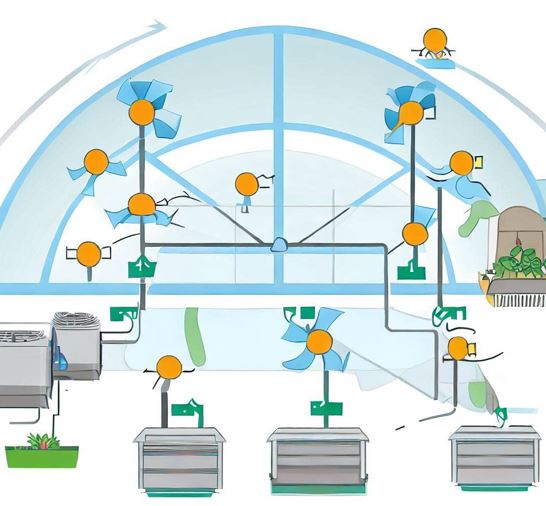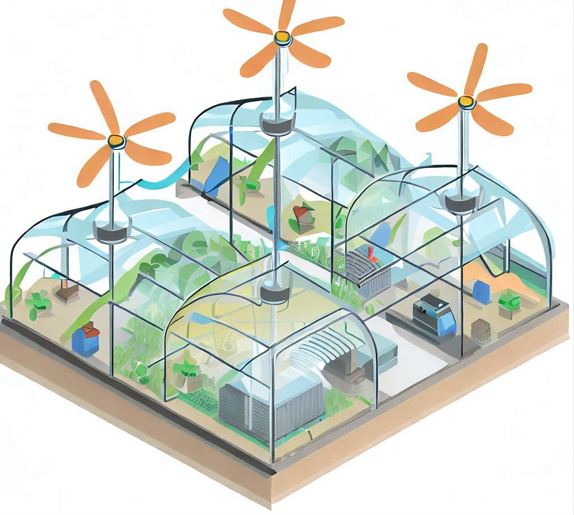Greenhouse Fan & Its Essential Roles
Introduction to Greenhouse Fans
As a gardening enthusiast and a dedicated advocate of greenhouse cultivation, I believe that the right equipment can make a significant difference in the success of your plants. Today, I want to shed light on an essential tool that often goes unnoticed but plays a vital role in maintaining a healthy greenhouse environment—the greenhouse fan. In this article, I’ll discuss the importance of proper airflow, guide you in selecting the right fan for your greenhouse, provide installation tips, highlight the benefits of using a fan, and offer additional suggestions to enhance your greenhouse’s overall success.
The importance of proper airflow in a greenhouse
A greenhouse provides an ideal environment for plants to thrive, but without proper airflow, it can become a stagnant and problematic space. Adequate air movement is crucial for maintaining optimal temperature, humidity, and carbon dioxide levels while preventing the growth of mold, mildew, and pests. It replicates the gentle breezes found in nature, ensuring that your plants receive the fresh air they need for healthy growth.
Benefits of using a greenhouse fan
A greenhouse fan is a simple yet powerful solution to promote airflow and maintain a balanced environment. By installing a fan, you can regulate temperature, prevent overheating, and control humidity levels. Additionally, the movement of air discourages pests and diseases, as they prefer still, stagnant conditions. A well-ventilated greenhouse with the aid of a fan creates a harmonious environment for your plants, leading to improved growth, increased yield, and overall plant health.
Selecting the Right Greenhouse Fan
When choosing a greenhouse fan, several factors should be considered to ensure it meets your specific needs.
Factors to consider when choosing a greenhouse fan
- Size and capacity: The fan’s size and capacity should be suitable for your greenhouse’s dimensions. Consider the cubic feet of air in your greenhouse and choose a fan that can efficiently move the air within that space.
- Energy efficiency: Opt for an energy-efficient fan to minimize electricity costs. Look for fans with high energy efficiency ratings or those equipped with energy-saving features such as variable speed controls.
- Noise level: Since a greenhouse is a tranquil space, it’s essential to select a fan with low noise levels. This way, you can enjoy the serenity of your greenhouse while still benefiting from the fan’s airflow.
Different types of greenhouse fans
There are various types of fans available for greenhouse use, each serving a specific purpose.
- Exhaust fans: These fans are typically installed on one wall or the roof to expel hot, stale air from the greenhouse. They create negative pressure, drawing fresh air in through vents or openings, promoting air exchange.
- Circulation fans: Positioned strategically throughout the greenhouse, circulation fans move air gently and evenly, maintaining consistent temperature and humidity levels. They are especially useful for larger greenhouses or those with multiple compartments.
- Evaporative cooling fans: These specialized fans work in conjunction with evaporative cooling systems. They promote evaporation, which has a cooling effect on the air, helping to reduce temperatures in hot climates or during summer months.
Installing and Positioning the Greenhouse Fan
Proper installation and positioning of the greenhouse fan are vital to ensure optimal airflow within your greenhouse.
Placement considerations for optimal airflow
- High and low positioning: For efficient air circulation, consider placing fans both high and low in your greenhouse. High-positioned fans help exhaust hot air, while low-positioned fans facilitate cool air intake.
- Distance from plants: Be mindful of the fan’s distance from your plants. While airflow is essential, direct drafts can be detrimental to some plants. Position the fan in a way that encourages gentle air movement without causing damage or stress to your foliage.
Proper installation techniques
When installing a greenhouse fan, it’s crucial to follow proper techniques to ensure its effectiveness and safety.
- Mounting options: Depending on the fan type, you may choose to mount it on a wall, suspend it from the ceiling, or attach it to an overhead support structure. Follow the manufacturer’s instructions for the specific fan model you have chosen.
- Electrical requirements and safety precautions: Ensure that the electrical connections and wiring are done correctly, following all safety guidelines and regulations. If you’re not confident in your electrical skills, consult a professional to ensure a safe and reliable installation.
Benefits of Using a Greenhouse Fan
Now that your greenhouse fan is installed and running smoothly, let’s explore the significant benefits it provides to your plants and the overall greenhouse environment.
Temperature regulation and control
One of the primary benefits of using a greenhouse fan is temperature regulation. Greenhouses can quickly become overheated, especially during summer months or in warm climates. A fan helps expel hot air and circulate cooler air, preventing temperature spikes that can stress or damage your plants. With a well-regulated temperature, your plants can thrive and reach their full growth potential.
Moreover, a greenhouse fan helps control humidity levels. Excessive humidity can lead to mold, mildew, and fungal diseases, harming your plants. By promoting air movement and preventing stagnant conditions, a fan aids in reducing humidity, creating a healthier and more balanced environment.
Disease prevention and pest control
Proper airflow is a natural defense against diseases and pests. A greenhouse fan disrupts still air, making it less attractive to problems such as aphids and spider mites. Additionally, increased air circulation reduces the risk of fungal diseases, as it inhibits the growth and spread of mold and mildew.
By incorporating a greenhouse fan into your setup, you create an environment that is less favorable to pests and diseases, minimizing the need for chemical interventions and promoting a healthier ecosystem for your plants.
Maintaining and Operating the Greenhouse Fan
To ensure the longevity and optimal performance of your greenhouse fan, regular maintenance and proper operation are essential.
Regular cleaning and maintenance
Regular cleaning is crucial to keep your greenhouse fan operating smoothly. Dust, debris, and pollen can accumulate on the fan blades, reducing their efficiency. Periodically clean the fan by gently wiping the blades with a damp cloth or using a soft brush to remove any build-up. Be sure to turn off the fan and disconnect the power before cleaning.
Additionally, inspect the fan for any signs of wear or damage, such as loose screws or bent blades. Replace any worn-out or damaged parts promptly to maintain the fan’s performance.
Adjusting fan speed and direction
Most greenhouse fans offer adjustable speeds to suit different environmental conditions. During hotter days, you can increase the fan speed to enhance air movement and cooling. On cooler days or during the night, you can reduce the fan speed to maintain a gentle airflow without chilling your plants.
Some fans also allow you to adjust the direction of airflow. Experiment with different directions to find the best configuration for your greenhouse layout and the specific needs of your plants.
Monitoring fan performance
Regularly check the fan’s performance to ensure it’s functioning optimally. Listen for any unusual sounds or vibrations, as they could indicate an issue that requires attention. If you notice any problems, such as decreased airflow or unusual noise, troubleshoot the fan or seek professional assistance if needed.
Keep an eye on the fan’s power consumption as well. A sudden increase in energy usage might indicate a problem with the fan’s motor or components. Monitoring the fan’s performance will help you catch any potential issues early on and maintain a healthy greenhouse environment.
Additional Tips for a Successful Greenhouse Environment
While a greenhouse fan is a valuable tool for airflow and climate control, there are other considerations to enhance your greenhouse’s success. Here are a few additional tips:
Supplemental ventilation options: Depending on your climate and specific greenhouse setup, you might benefit from additional ventilation options, such as side vents, roof vents, or louvers. These openings can complement the fan’s airflow, providing additional avenues for fresh air intake and heat dissipation.
Proper greenhouse design for optimal airflow: When designing or renovating your greenhouse, consider factors that facilitate airflow, such as the layout, the size and placement of doors and windows, and the materials used. A well-designed greenhouse with thoughtfully placed openings can promote natural air movement and work harmoniously with your greenhouse fan.
Complementary tools and techniques for climate control: In conjunction with a greenhouse fan, you can employ other tools and techniques to maintain an ideal growing environment. These may include shade cloths to reduce heat stress, misting systems to increase humidity, or thermal screens to insulate during colder periods. Explore these options to customize your greenhouse’s climate control strategy.

Conclusion:
As an expert and enthusiast in the field of greenhouse gardening, I can confidently say that a greenhouse fan is a valuable asset for any gardener. It plays a vital role in maintaining optimal airflow, temperature regulation, and disease prevention within your greenhouse. By selecting the right fan, installing it correctly, and incorporating regular maintenance, you can create an environment where your plants can thrive and reach their full potential.
Remember to choose a fan that suits the size and specific requirements of your greenhouse. Position it strategically to promote proper airflow while considering the needs of your plants. Regularly clean and maintain the fan to ensure its efficiency, and monitor its performance to catch any issues early on.
By combining a greenhouse fan with a thoughtful greenhouse design, supplemental ventilation options, and complementary tools, you can create a thriving greenhouse environment. Enjoy the rewards of healthier, more robust plants and the satisfaction of successful greenhouse gardening.
FAQs
- How do I know what size greenhouse fan I need?
The size of the greenhouse fan depends on the cubic feet of air in your greenhouse. Calculate the volume by multiplying the width, length, and height of the greenhouse. Aim for a fan that can move the air in the greenhouse every one to two minutes for optimal results. - Can I use a regular household fan in my greenhouse?
While a regular household fan might provide some airflow, it’s not designed for the specific requirements of a greenhouse. Greenhouse fans are built to withstand the moisture and temperature fluctuations found in greenhouse environments. It’s recommended to invest in a fan specifically designed for greenhouse use. - Can I use multiple fans in my greenhouse?
Yes, using multiple fans strategically placed in your greenhouse can enhance airflow and promote better air circulation. Experiment with different fan placements to find the configuration that works best for your greenhouse’s layout and your plants’ needs. - Are greenhouse fans energy efficient?
Many greenhouse fans are designed with energy efficiency in mind. Look for fans with high energy efficiency ratings or those equipped with features like variable speed controls, which allow you to adjust the fan’s power consumption based on the specific requirements of your greenhouse. - Can a greenhouse fan eliminate the need for other ventilation options?
While a greenhouse fan is an essential component for airflow, it might not be sufficient on its own, especially in larger or more complex greenhouse setups. Consider additional ventilation options like side vents or roof vents to complement the fan’s airflow and provide additional fresh air intake and heat dissipation.





